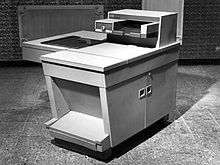Xerox 914
The Xerox 914 was the first successful commercial plain paper copier which in 1959 revolutionized the document-copying industry. The culmination of inventor Chester Carlson's work on the xerographic process, the 914 was fast and economical. The copier was introduced to the public on September 16, 1959, in a demonstration at the Sherry-Netherland Hotel in New York, shown on live television.[1]

Background
Xerography, a process of producing images using electricity, was invented in 1938 by physicist-lawyer Chester Floyd "Chet" Carlson (1906–1968), and an engineering friend, Otto Kornei. Carlson entered into a research agreement with the Battelle Memorial Institute in 1944, when he and Kornei produced the first operable copy machine. He sold his rights in 1947 to the Haloid Company, a wet-chemical photocopy machine manufacturer, founded in 1906 in Rochester, New York.
Haloid introduced the first commercial xerographic copier, the Xerox Model A, in 1949. The company had, the previous year, announced the refined development of xerography in collaboration with Battelle Development Corporation, of Columbus, Ohio. Manually operated, it was also known as the Ox Box. An improved version, Camera #1, was introduced in 1950. Haloid was renamed Haloid Xerox in 1958, and, after the instant success of the 914, when the name Xerox soon became synonymous with "copy", would become the Xerox Corporation.
In 1963, Xerox introduced the first desktop copier to make copies on plain paper, the 813. It was designed by Jim Balmer and William H. Armstrong of Armstrong-Balmer & Associates, and won a 1964 Certificate of Design Merit from the Industrial Designers Institute (IDI). Balmer had recently left Harley Earl, Inc., where he had been a designer since 1946, to co-establish Armstrong-Balmer & Associates in 1958. At Earl, Balmer had been involved in the Secretary copy machine designed for Thermofax and introduced by 3M in 1958, and Haloid Xerox had been impressed with the design, engaging Balmer to consult on the final design of the 914.
A year later, in 1964, Balmer worked with Xerox to establish their first internal industrial design group. Among those first design employees were William Dalton and Robert Van Valkinburgh.
Specifications and features
One of the most successful Xerox products ever, the 914 model (so-called because it could copy originals up to 9 inches by 14 inches (229 mm × 356 mm)) could make 100,000 copies per month (seven copies per minute). In 1985, the Smithsonian received a Xerox 914, number 517 off the assembly line. It weighs approximately 650 pounds[2] (294 kg) and measures 42" (107 cm) high × 46" (117 cm) wide × 45" (114 cm) deep.
The machine was mechanically complex. It required a large technical support force,[2] and had a tendency to catch fire when overheated. Because of the problem, the Xerox company provided a "scorch eliminator", which was actually a small fire extinguisher, along with the copier.[1] But despite these problems, the machine was regarded with affection by its operators, due to it being complex enough to be interesting to use, but without being so complex as to be beyond understanding.[3]
The pricing structure of the machine was designed to encourage customers to rent rather than buy - it could be rented in 1965 for $25+10cents per copy per month.There was a meter, the customer read the meter filled out a card and mailed it in each month .But would cost $27,500 to buy.[2] The purchase price was established by the US Government because they would not rent equipment. The customer also bought paper and toner (ink) at a cost of about .05 per copy.
Sales
The 914 was a significant component of Xerox's revenues in the mid-1960s, with one author estimating that the machine accounted for two thirds of the company's revenue in 1965, with income generated of $243M.[2] The machine was produced between 1960 and 1977.[4]
Legacy
The company's subsequent models were the Xerox 710, the Xerox 1000, the Xerox 813 and the Xerox 2400. One writer has assessed that the popularity of the machine has had a number of lasting impacts, such as prompting the introduction of highlighter pens, and university reading lists in the form of anthologies, rather than chapters from separate books.[4]
In popular culture
The arrival of a Xerox 914 is a cultural signifier in the 2nd season of Mad Men, set in a 1961 Manhattan advertising agency. It is acquired specifically to impress a potential client with how modern the agency is.
References
- Hemmungs Wirtén, Eva (2004). No Trespassing: Authorship, Intellectual Property Rights, and the Boundaries of Globalization. University of Toronto Press.
- Brooks, p. 17
- Brooks, p. 18
- Edward Tenner. "The Mother of All Invention". The Atlantic. Retrieved 10 October 2015.
Further reading
- Brooks, John, (1967) 'Xerox Xerox Xerox Xerox' The New Yorker Magazine, Apr 1 and available at Gatesnotes.com
- Owen, David (2004). Copies in Seconds: Chester Carlson and the Birth of the Xerox Machine. Simon & Schuster. ISBN 978-1-4223-5892-4.
- Tenner, Edward (July–August 2010). "The Mother of All Invention". The Atlantic. Retrieved 2010-06-12.